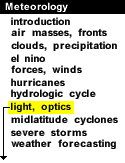
|

Graphic by: Yiqi Shao
Rainbows, sunsets and halos; a spectacular display of colors and visuals in the sky called "atmospheric optics". As sunlight (or moonlight) enters the atmosphere, it is either absorbed, reflected, scattered, refracted or diffracted by atmospheric particles or air molecules. These processes, individually or in combination, are responsible for producing most optical effects. This module investigates these particle-light interactions and the assortment of optical effects they produce. The Light and Optics module has been organized into the following sections:
| Sections
Last Update: 08/26/99 |
Mechanisms
Particle/Molecule-light interactions responsible for creating optical effects. These interactions include: reflection, scattering, refraction and diffraction.
Air, Dust, Haze
Ice Crystals
Water Droplets
Acknowledgments
|
The type of optical effect that results greatly depends upon the type of particles the light encounters and on the wavelength of the light. For this reason, the optical effects discussed in this module have been grouped according to the following classifications of atmospheric particles: air, dust and haze, ice crystals, and water droplets.
The navigation menu (left) for this module is called "Light, Optics" and the menu items are arranged in a recommended sequence, beginning with this introduction. In addition, this entire web server is accessible in both "graphics" and "text"-based modes, a feature controlled by the blue "User Interface" menu (located beneath the black navigation menus). More information about the user interface options, the navigation system, or WW2010 in general is accessible from About This Server.

Hydrologic Cycle |
|

mechanisms |



